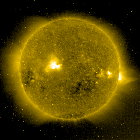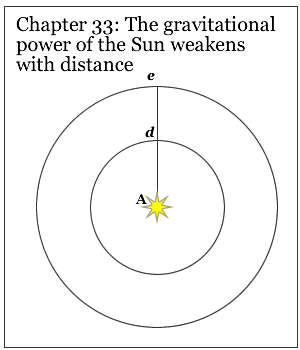Kepler wanted to know how the Solar System works, not just to describe it with mathematical formulas. In Part III of The New Astronomy he searched for and identified the physical causes of planetary motion.

First, Kepler proves in Chapter 32 that Ptolemy’s “equant” makes a planet’s speed increase or decrease in direct proportion to its distance from the Sun. In Donahue’s words, Kepler was arguing “that Ptolemy’s equant is really a flawed geometrical expression of [a] dynamic principle.” (emphasis added)
Kepler introduces Chapter 33 with the heading: “The power that moves the planets resides in the body of the Sun.”
He explains that even if he were not to engage in lengthy proofs but simply to assert a priori that the Sun is the center of the world this opinion would deserve an equal hearing based on the “worthiness and eminence of the Sun” alone. The Sun after all is the “source of the light which forms the adornment of the entire [Solar System]” and “also the source of the heat by which everything grows.” To these observations Kepler added that the Sun is “the source of the world’s life (which is visible in the motion of the heavens).”
But what is the power that moves the planets? Kepler called it an “immaterial species of the solar body.”
The word, species, related to the Latin verb “specio” (to see), has a range of meanings in the original Latin including “surface,” “form,” “semblance,” “mental image,” “sort,” “nature,” or “archetype,” among other things.

Kepler stated that, like the power of a lever moving something alternately near or far from the fulcrum, the “weakening power is the ratio of the distances.” He also postulated that like light “the power is weaker to the extent that it is more spread out.”
Here, Kepler anticipated the inverse square law of gravitation.
Musing on the metaphysical nature of gravity, Kepler speculated, “nothing of this power is lost in traveling from its source, nothing is scattered between the source and the movable body."
Given that today we remain substantially uncertain about what gravitation actually is (the geometrical descriptions of General Relativity aside), Kepler's metaphysical speculations remain salient.
He continued, "The emission, then, in the same manner as light, is immaterial, unlike odors, which are accompanied by a diminution of substance, and unlike the heat from a hot furnace, or anything similar which fills the intervening space.”
The motive power, an “immaterial species of its source,” “never inheres in anything except a mobile subject, such as the body of a planet. Although it is “poured out through the whole world,” from one standpoint it is as if “it does not exist anywhere but where there is something movable.” (Selections from Kepler's Astronomia Nova, William H. Donahue, pp. 55-62)
Kepler also thought the Sun rotates in space (a fact later borne out by experience) and likens the “Sun’s body to a magnet,” using magnetism as well as light as an analogy for the “immaterial species.” This, he said, is “little short of being the very truth.” He noted how the English physician and physicist William Gilbert (1544-1603) demonstrated in his 1600 book De Magnete (On The Magnet) that the Earth itself is a magnetic body.
Kepler expanded his concept of the immaterial species to the other bodies in the solar system, proposing that the Earth moves the Moon through its own "immaterial species." “This our Earth,” he writes, “occasions the motions of the Moon…through its species.”
"Everything fits: the Earth is intimately related to the lunar period, just as the Sun is to that of the other planets." (Selections from Kepler's Astronomia Nova, William H. Donahue, p. 70)
How does this species express itself in the harmonic characteristics of the planetary system?



